July 30, 2025
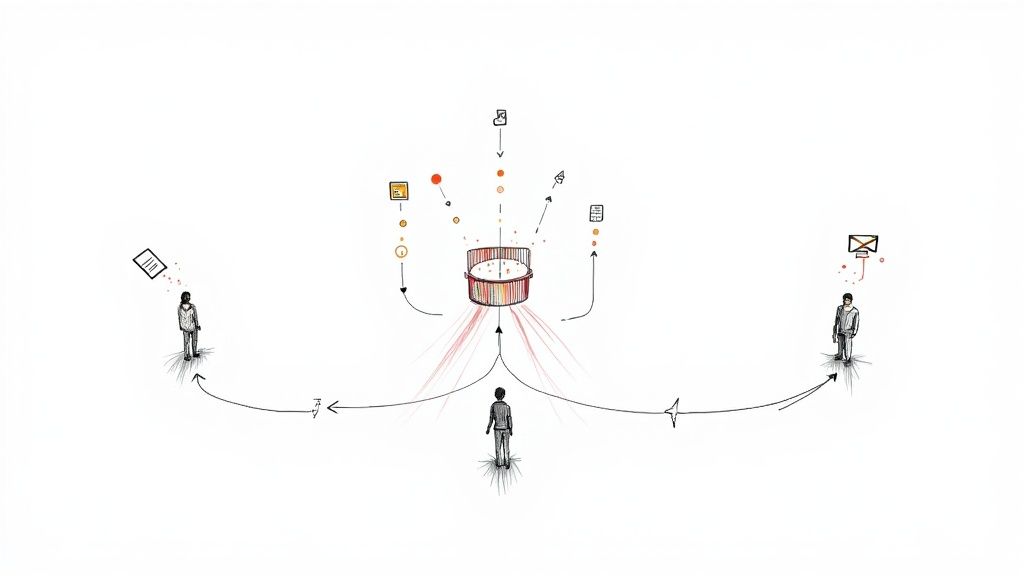
The most successful exhibitors know a secret: the real work of trade show lead generation happens long before anyone steps foot on the convention floor. This is where the pros separate themselves from the amateurs. A winning strategy isn't about having the flashiest booth; it's about meticulous pre-show planning that connects your marketing activities directly to your sales targets.
Success at a trade show isn't a matter of luck. It's built on a foundation of smart, strategic work done weeks, or even months, in advance. Just booking a booth and showing up is a recipe for a disappointing ROI. The real magic lies in a detailed pre-show plan designed to pull the right kind of traffic to your booth and give your team the intel they need to have meaningful conversations.
This isn't just about logistics. It's about running a full-fledged marketing campaign that turns your booth from a passive stop on the floor map into an active, must-see destination.
First things first: you need to define what a "win" actually looks like. Vague goals like "get more leads" are completely useless. You need to get specific and tie your objectives to real business outcomes, like sales quotas and marketing KPIs.
For example, your goals might look something like this:
When you set concrete targets like these, you give your team a clear finish line to run toward. It also gives you a solid benchmark for measuring your true ROI when the dust settles.
Most shows will give you access to a pre-registered attendee list. This list is pure gold, but only if you use it. Don't just give it a quick scan—get your team to dig in and cross-reference it with your ideal customer profile (ICP) and the accounts in your CRM. You're hunting for high-value targets.
Look for specific job titles, companies you've been trying to break into, and even past customers who might be ready for an upsell. This is your chance to build a "most wanted" list for your booth team.
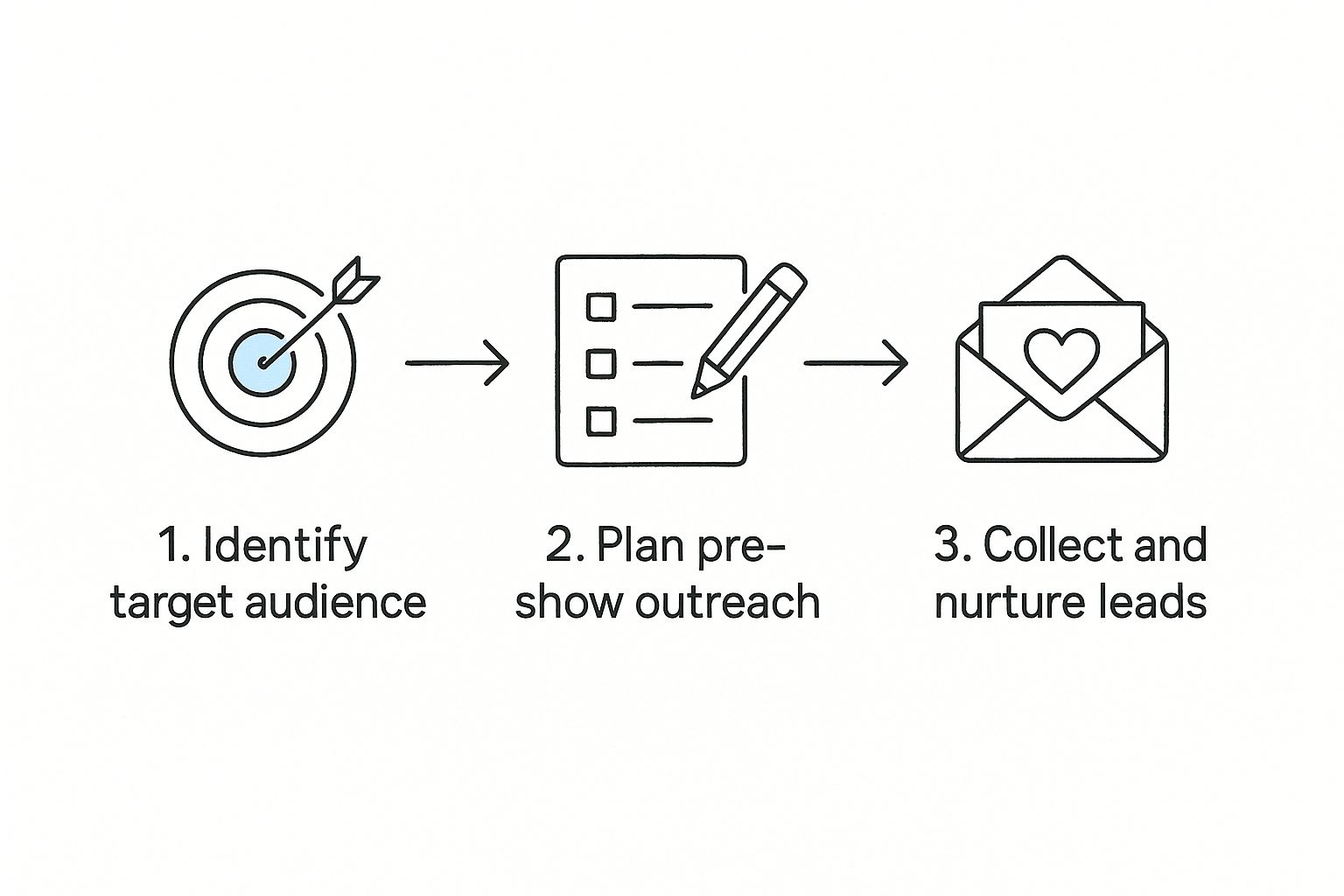
As you can see, this isn't about a single action. It's a connected process where every stage, from targeting to follow-up, builds on the last.
Before you jump into outreach, make sure your team is aligned and ready. This checklist helps ensure nothing falls through the cracks in the critical weeks leading up to the show.
Having this structure in place turns your pre-show efforts from a chaotic scramble into a well-oiled machine.
Once your hit list is ready, it's time to start making contact. A single email blast won't cut it. You need a multi-channel approach that surrounds your key prospects. A great starting point is creating a dedicated event landing page where people can see what you're doing at the show and, most importantly, book a meeting directly on your sales team's calendar.
From my own experience, I can tell you that a personalized email mentioning a prospect's recent LinkedIn post or company news is 10x more likely to get a response than a generic "Visit our booth!" message. Make your outreach feel exclusive and genuinely helpful.
Your entire pre-show campaign should build anticipation. Tease a new product you'll be unveiling. Run a contest where attendees can claim a high-value prize at your booth. Promote an exclusive "ask me anything" session with one of your top engineers. Your job is to make a visit to your booth a non-negotiable item on every key prospect's agenda.
It’s also smart to understand the attendance dynamics of the specific show. Post-pandemic recovery has been inconsistent. For instance, the National Restaurant Association Show saw attendance grow 41% above pre-pandemic levels, while CES attendance is still lagging. What's crucial to remember is that about 81% of trade show attendees have buying authority, making them incredibly valuable. However, with nearly 46% attending only one show per year, your pre-show marketing has to be compelling enough to break through the noise. You can dig into more detailed attendance trends to see how different industries are bouncing back.
Let's be honest, your trade show booth is more than just a slice of rented floor space; it's the heart of your entire lead generation effort for the event. Surrounded by a sea of competitors, your booth needs to be a magnet, pulling in the right people and creating a space where real conversations can flourish. You're not just building a display; you're designing an experience.
One of the biggest mistakes I see exhibitors make is setting up their booth like a fortress, with a big table right at the front. Don't do that. Instead, pull your main displays and counters to the back and sides. This creates an open, welcoming layout that invites people to walk into your space, not just shuffle past it. Think of it like a retail shop—you want to encourage people to come in and browse.
You have about three seconds to grab someone's attention as they walk down the aisle. That's it. Your main message has to be crystal clear, bold, and visible from a distance. It must immediately answer the visitor's unspoken question: "What's in it for me?"
Avoid the temptation to wallpaper your booth with a laundry list of product features. Nobody cares. Focus on a single, compelling outcome. For example, instead of a sign that says "AI-powered analytics, CRM integration, and automated reporting," try something like this: "Stop Guessing. Start Growing. Predictive Analytics for B2B Sales." That headline instantly tells B2B sales leaders you can solve a problem they have and makes them curious to learn more.
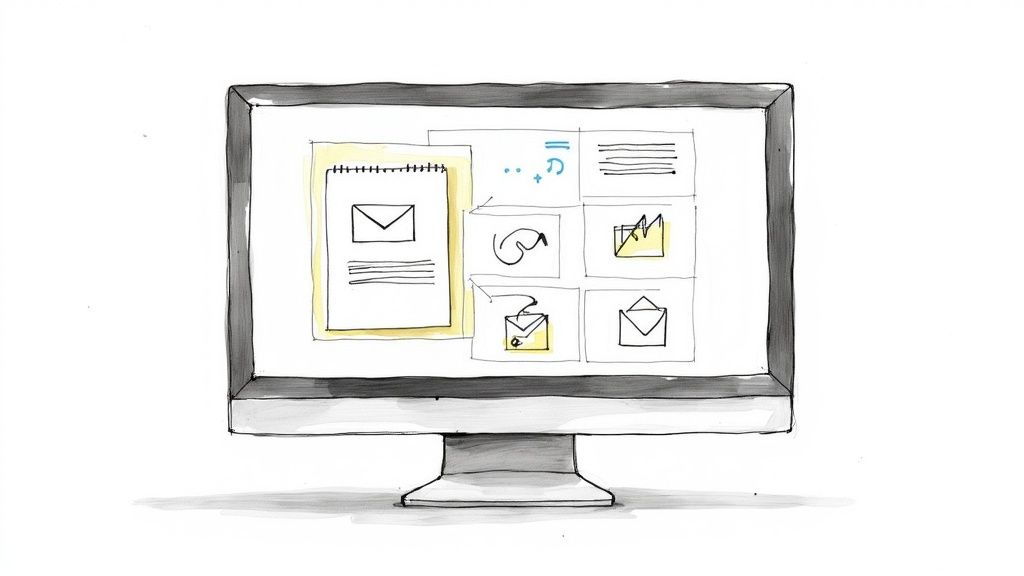
A passive booth with a bowl of candy and some brochures is completely forgettable. If you want to make a lasting impression and actually generate qualified leads, you need to get people involved. Interactive elements engage the senses, encourage participation, and turn a quick stop into a memorable experience.
Here are a few ideas that work wonders:
These activities give people a reason to stick around, which buys your team precious time to strike up conversations and fill your trade show lead generation pipeline.
Your booth staff will make or break your entire event. I can't stress this enough. They aren't just there to smile and scan badges; they are the front line of your sales and qualification process. Sending unenthusiastic or untrained staff to a show is like setting a pile of money on fire.
The single biggest differentiator between a good and a great exhibitor is the booth team. A well-trained team member knows how to ask open-ended qualifying questions instead of just scanning a badge and saying, "Thanks for stopping by." They transform a passive interaction into an active sales opportunity.
Your pre-show training should be sharp and focused. Here’s what every team member must know:
When you combine an inviting space, a clear message, interactive fun, and a well-prepped team, you stop just "exhibiting" and start building a high-performance trade show lead generation machine.
The trade show floor is electric. It's loud, it's crowded, and every single conversation could be a game-changer for your business. This is where all your planning gets put to the test. Success here comes down to one thing: how well your team can capture, qualify, and prioritize leads in the middle of the action.
Let's be clear: tossing business cards into a fishbowl and hoping for the best isn't a strategy. It's a waste of money. Today, smart trade show lead generation is about turning a fleeting chat into actionable intelligence for your sales team.
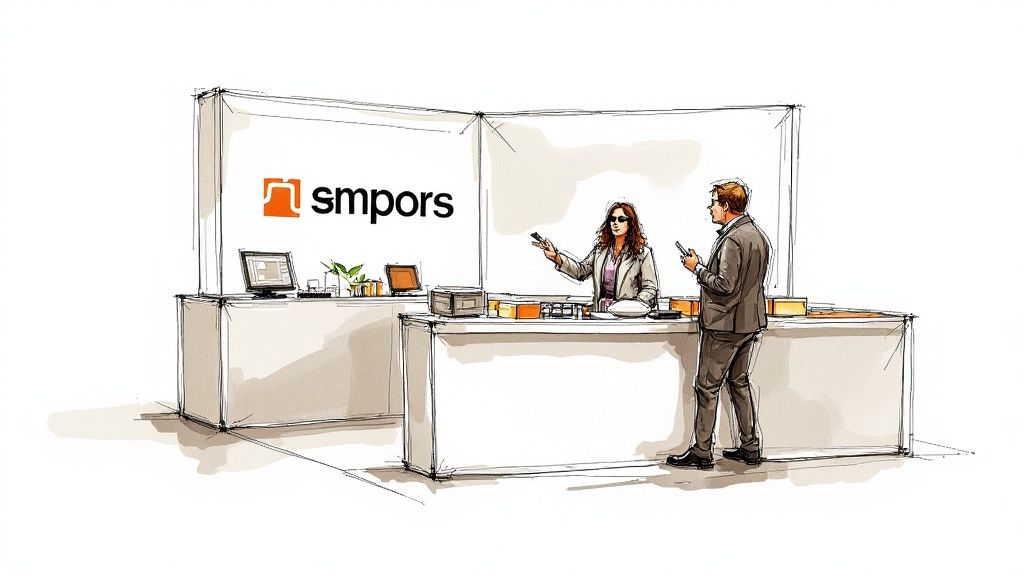
The best exhibitors I see have completely ditched pen and paper. Their teams are armed with modern trade show lead capture tools, like badge scanners and dedicated apps on their phones or tablets. These tools do so much more than just grab a name and an email.
With a quick scan, your team gets a full profile and can immediately add crucial context. This is what turns a cold contact into a warm, detailed handover for your sales crew.
Think about the difference. Instead of a business card, your salesperson gets notes like:
You just can't manage that level of detail with a stack of cards. We get into the nitty-gritty of specific tools in our guide on optimizing trade show lead capture.
The tech is only half the battle. Your booth staff needs to be coached on asking smart questions that get right to the heart of a prospect's problems. The goal is to shift from polite small talk to a real, consultative conversation—and do it fast.
Steer clear of questions that can be answered with a simple "yes" or "no." You want to ask open-ended questions that get people talking about their challenges and goals.
Effective Qualifying Questions
These kinds of questions help you quickly figure out someone's pain points, their role in the buying process, and how urgently they need a solution.
A well-phrased question is the most powerful tool you have on the show floor. It can turn a two-minute chat into a qualified lead by uncovering a critical business need that you are perfectly positioned to solve. It separates the casual browsers from the serious buyers.
Let's be honest, not all leads are created equal. Your team needs a dead-simple way to separate the hot prospects from the tire-kickers. Setting up a basic lead scoring system right inside your capture app is a game-changer for post-show efficiency.
You can go with a simple "hot," "warm," or "cold" rating, or get a little more detailed. A great framework to start with is BANT (Budget, Authority, Need, Timeline).
This kind of on-the-spot segmentation lets your sales team hit the ground running after the show, focusing their energy where it matters most. And that's critical. While 72% of exhibitors go to shows for new leads, a staggering 6% feel confident in converting them. The key is follow-up speed, especially when converting a trade show lead is 38% less expensive than a traditional sales call. That opportunity window closes fast.
By scoring leads right on the floor, you're building the foundation for the swift, targeted follow-up that actually drives revenue.
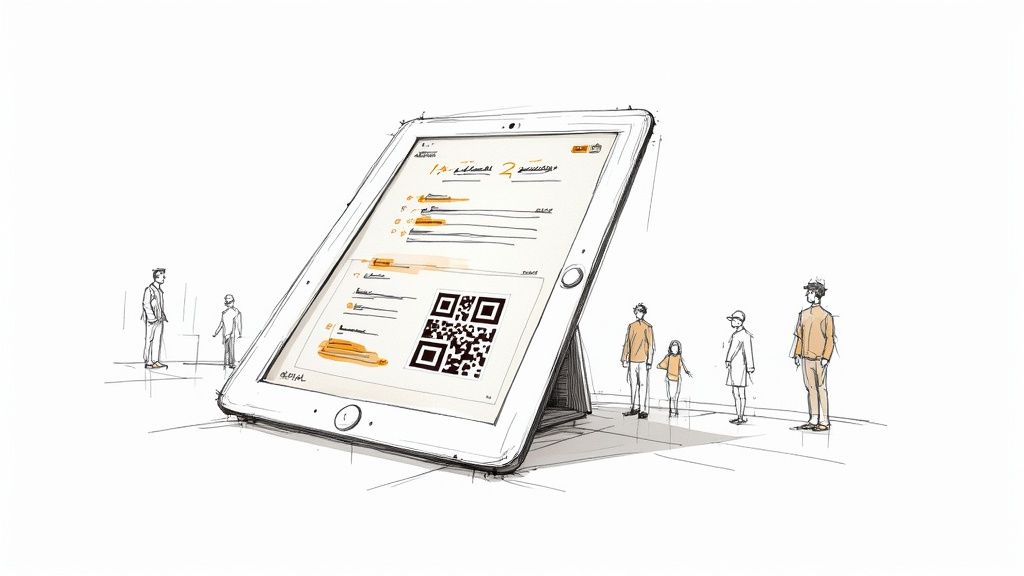
In a crowded exhibit hall, the smartest exhibitors almost always have a technological edge. It's not just about having a flashy booth anymore. The right digital tools can genuinely transform the efficiency and impact of your trade show lead generation. This isn't about using tech for tech's sake; it’s about building a smarter, more measurable lead engine.
The real goal is to find tech that either makes your team’s job easier or creates a more memorable experience for attendees. When you manage to do both, your ROI can climb dramatically.
Most modern trade shows offer their own event app or use smart badges with NFC or QR codes. You should treat these tools as your new best friend. Instead of awkwardly fumbling with business cards or a clunky scanner, you can capture rich, pre-populated data with a simple tap.
But just scanning isn't enough. The magic happens in what you do immediately after. Your booth staff must be trained to use the app to add quick qualifying notes, tag specific product interests, and set a priority level for follow-up—all before the attendee even walks away.
I’ve seen teams double their qualified lead count simply by mastering the event app. While others were just scanning and moving on, this team took an extra 30 seconds to add a key conversation note. That context transformed a cold name into a hot, actionable lead for the sales team.
This simple habit turns a basic contact swap into a detailed data transfer, giving your post-show follow-up incredible power and personalization.
How do you stand out in a sea of booths all vying for attention? You stop being a display and start being an experience. This is where technologies like Augmented Reality (AR) can make a huge difference, turning your booth into a can't-miss destination on the show floor.
Imagine a prospect pointing their phone at one of your physical products and seeing a 3D model explode into its component parts, complete with feature callouts. Or what about an AR-powered scavenger hunt where attendees find virtual objects around your booth to win a prize?
These kinds of interactions do more than just attract a crowd. They generate organic social media buzz and leave a lasting brand impression that a simple brochure never could. For more inspiration, check out these creative marketing ideas for events that can help you break the mold.
What if you could engage and pre-qualify visitors even when your entire team is deep in conversation? That's the power of an AI-powered chatbot. Positioned on a tablet at a kiosk, a chatbot can be your tireless assistant.
It can handle common questions, point visitors toward relevant product info, and even book demos directly into your sales team's calendars. This frees up your human staff to focus on the high-value, nuanced conversations with your most promising prospects.
By weaving these tools together, you're not just adding gadgets; you're building a more cohesive and efficient system. The shift from old-school methods to a tech-forward approach is pretty stark when you see it side-by-side.
In the end, technology acts as a force multiplier. It empowers your team to be more effective, makes your booth more engaging, and ensures your entire trade show lead generation process is smarter and more data-driven from start to finish.
https://www.youtube.com/embed/FmynoFX0p0E
The event might be over, but let's be honest—the real work, the part that actually generates revenue, is just getting started. That stack of scanned badges is nothing more than expensive data until you put it to work. The speed and quality of your follow-up are what separate a massive ROI from a completely wasted opportunity.
The single biggest mistake I see companies make is waiting. That buzz and genuine interest a prospect felt at your booth has an incredibly short half-life. A personal, relevant touchpoint delivered within 24 hours is light-years more effective than a generic email blast sent a week later.
Before you even think about writing an email, you have to organize your leads. This is precisely why scoring leads on the show floor is so critical. Your first move is to sort all those contacts into buckets based on the priority your booth team assigned them.
Your segments should look something like this:
This simple act of segmentation ensures you’re applying the right amount of pressure and providing the most relevant information to each group, which is the key to working smart, not just hard.
Your follow-up shouldn't be confined to a single channel. The most successful campaigns I've ever run layer email, phone calls, and even social media to create a persistent, yet helpful, presence. The goal is to make every touchpoint feel like a natural continuation of the conversation you started at the show.
For your Hot Leads, the sequence needs to be urgent and personal.
This high-touch approach proves you were listening and that you value their time.
A study by Lead Connect found that 78% of customers buy from the company that responds to their inquiry first. Speed isn’t just a nice-to-have; it's your single biggest competitive advantage in post-show follow-up.
For Warm Leads, the game is all about nurturing that initial spark of interest over time. An automated email sequence is your best friend here.
The goal here is to provide value and stay top-of-mind until they're ready to engage further. This is so much more effective than just crossing your fingers and hoping they remember you. A solid follow-up strategy is just as crucial as your pre-show hype. You can find more ways to bridge your pre- and post-show activities in our guide to powerful event promotion ideas.
Let's face it: generic follow-up emails are deleted on sight. True personalization is your secret weapon, and this is where those detailed notes your booth team took become worth their weight in gold.
Reference the specific challenges they brought up, the product they were eyeing, or even a small personal detail from your conversation.
Instead of a lazy, "Thanks for visiting our booth," try something like, "It was great hearing about your plans to launch a new certification program in Q4. I’ve attached a case study on how we helped [Similar Company] do just that."
That level of detail instantly rebuilds the rapport you established on the show floor. It proves you listened and understood their unique situation, making them far more likely to respond and take the next step.
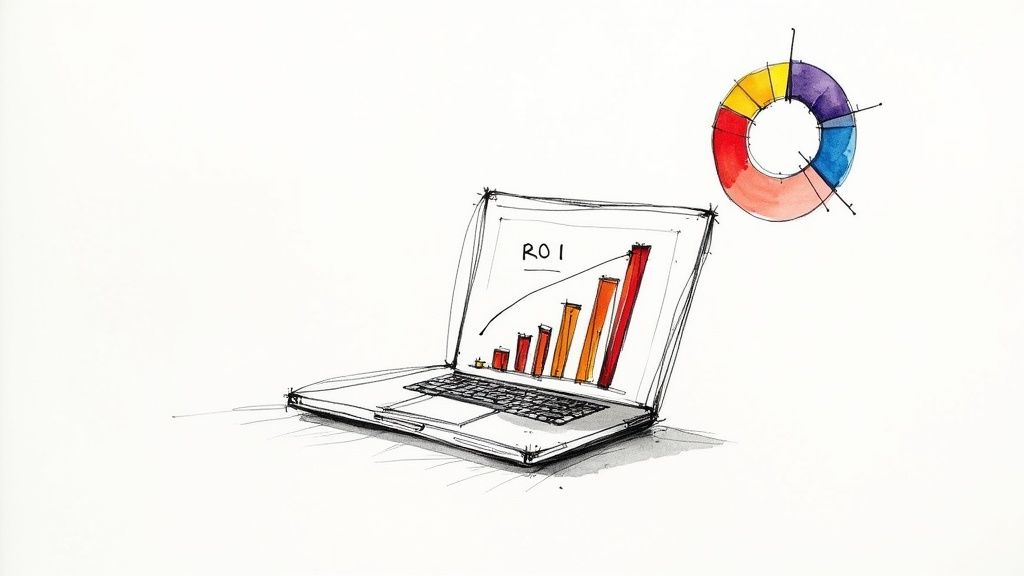
Even veteran exhibitors have nagging questions about getting the most out of their event budget. I get it. The world of trade show lead generation can feel complex, but it really boils down to having a solid plan.
Let’s dig into some of the most common questions I hear from teams on the ground.
Getting a true sense of your return on investment is so much more than just counting badge scans. You need to follow the money, and that means tracking leads all the way through your sales pipeline. First things first, get a handle on your total event cost—that’s everything from the booth space and travel to staffing and sponsorships.
With that number in hand, you can start tracking the leads you captured. The gold standard metric here is Customer Lifetime Value (CLV) from the deals that close because of the show. For instance, if you spent $30,000 on the event and it led to new customers worth $150,000 in lifetime value, you’re looking at a fantastic 5:1 ROI.
One of the biggest mistakes I see is only looking at immediate sales. Many deals that start at a trade show have a longer sales cycle. You really need to track conversions for at least 6-12 months to see the full financial impact.
Don't forget the "softer" metrics, either. Things like meetings booked with target accounts, press mentions, or new partnership talks all add long-term value that a simple lead count will never show you.
It's painful, but a lot of exhibitors make the same preventable mistakes. Knowing what they are is half the battle.
The most glaring blunder? Sending untrained staff to man the booth. Your front-line team has to be more than just present; they need to be engaging, deeply understand your product’s value, and know how to ask smart qualifying questions. The other classic error is a painfully slow follow-up. Research shows that 78% of customers buy from the company that gets back to them first. If you wait a week to reach out, you’ve already lost.
Here are a few other pitfalls I see time and again:
Good news: you don't need the biggest booth or the flashiest budget to win at lead generation. Smaller businesses can punch way above their weight by being smarter and more targeted. Instead of trying to be everything to everyone, laser-focus on a specific niche that aligns perfectly with your ideal customer.
Your real advantage is your ability to be personal and nimble. Use highly targeted pre-show outreach to lock in a few key meetings with decision-makers you know you need to talk to. At the show, prioritize quality over quantity. Aim for deep, memorable conversations. A small, passionate team can often create a more authentic and lasting impression than a massive, impersonal one.
Ready to transform your events and supercharge your community engagement? GroupOS provides an all-in-one platform to manage memberships, events, and content seamlessly. Schedule a free demo of GroupOS and see how you can build a powerful, branded hub for your organization.


